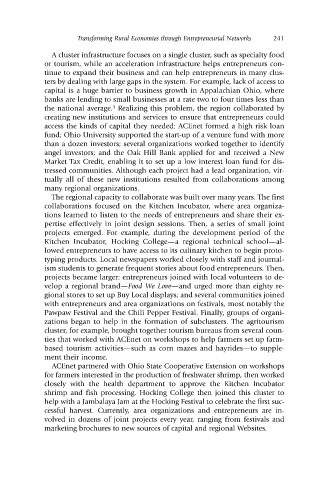Page 252 - 1-Entrepreneurship and Local Economic Development by Norman Walzer (z-lib.org)
P. 252
Transforming Rural Economies through Entrepreneurial Networks 241
A cluster infrastructure focuses on a single cluster, such as specialty food
or tourism, while an acceleration infrastructure helps entrepreneurs con-
tinue to expand their business and can help entrepreneurs in many clus-
ters by dealing with large gaps in the system. For example, lack of access to
capital is a huge barrier to business growth in Appalachian Ohio, where
banks are lending to small businesses at a rate two to four times less than
the national average. Realizing this problem, the region collaborated by
3
creating new institutions and services to ensure that entrepreneurs could
access the kinds of capital they needed: ACEnet formed a high risk loan
fund; Ohio University supported the start-up of a venture fund with more
than a dozen investors; several organizations worked together to identify
angel investors; and the Oak Hill Bank applied for and received a New
Market Tax Credit, enabling it to set up a low interest loan fund for dis-
tressed communities. Although each project had a lead organization, vir-
tually all of these new institutions resulted from collaborations among
many regional organizations.
The regional capacity to collaborate was built over many years. The first
collaborations focused on the Kitchen Incubator, where area organiza-
tions learned to listen to the needs of entrepreneurs and share their ex-
pertise effectively in joint design sessions. Then, a series of small joint
projects emerged. For example, during the development period of the
Kitchen Incubator, Hocking College—a regional technical school—al-
lowed entrepreneurs to have access to its culinary kitchen to begin proto-
typing products. Local newspapers worked closely with staff and journal-
ism students to generate frequent stories about food entrepreneurs. Then,
projects became larger: entrepreneurs joined with local volunteers to de-
velop a regional brand—Food We Love—and urged more than eighty re-
gional stores to set up Buy Local displays; and several communities joined
with entrepreneurs and area organizations on festivals, most notably the
Pawpaw Festival and the Chili Pepper Festival. Finally, groups of organi-
zations began to help in the formation of subclusters. The agritourism
cluster, for example, brought together tourism bureaus from several coun-
ties that worked with ACEnet on workshops to help farmers set up farm-
based tourism activities—such as corn mazes and hayrides—to supple-
ment their income.
ACEnet partnered with Ohio State Cooperative Extension on workshops
for farmers interested in the production of freshwater shrimp, then worked
closely with the health department to approve the Kitchen Incubator
shrimp and fish processing. Hocking College then joined this cluster to
help with a Jambalaya Jam at the Hocking Festival to celebrate the first suc-
cessful harvest. Currently, area organizations and entrepreneurs are in-
volved in dozens of joint projects every year, ranging from festivals and
marketing brochures to new sources of capital and regional Websites.

